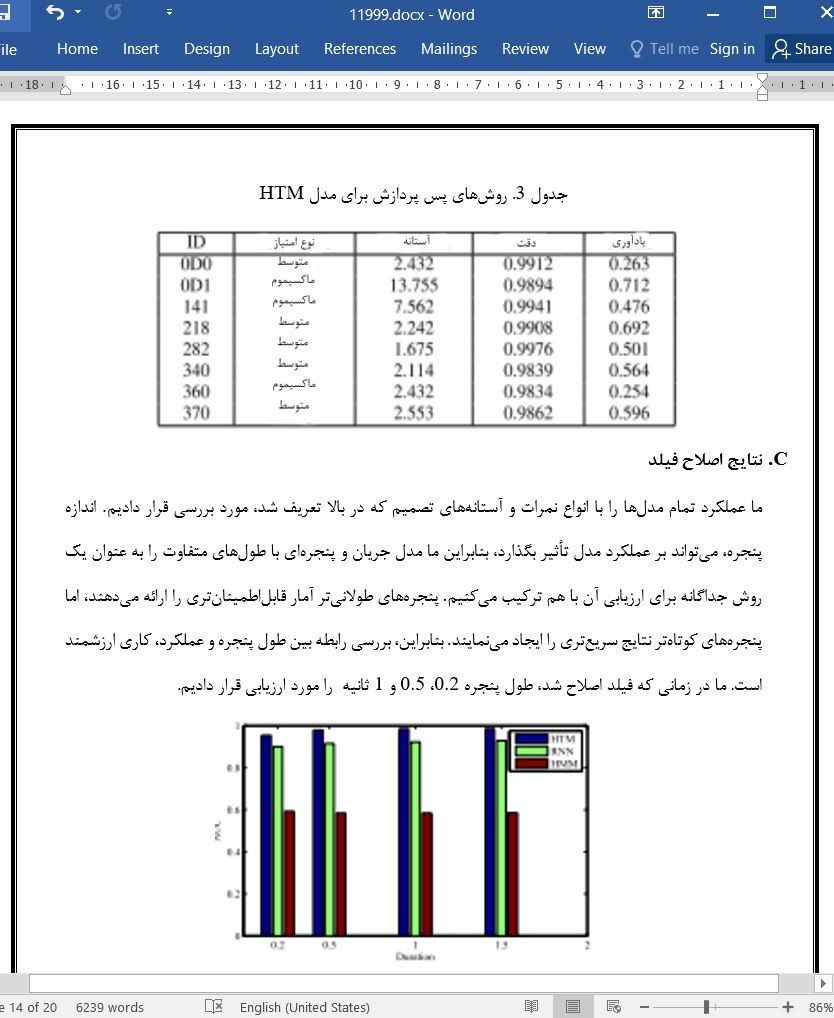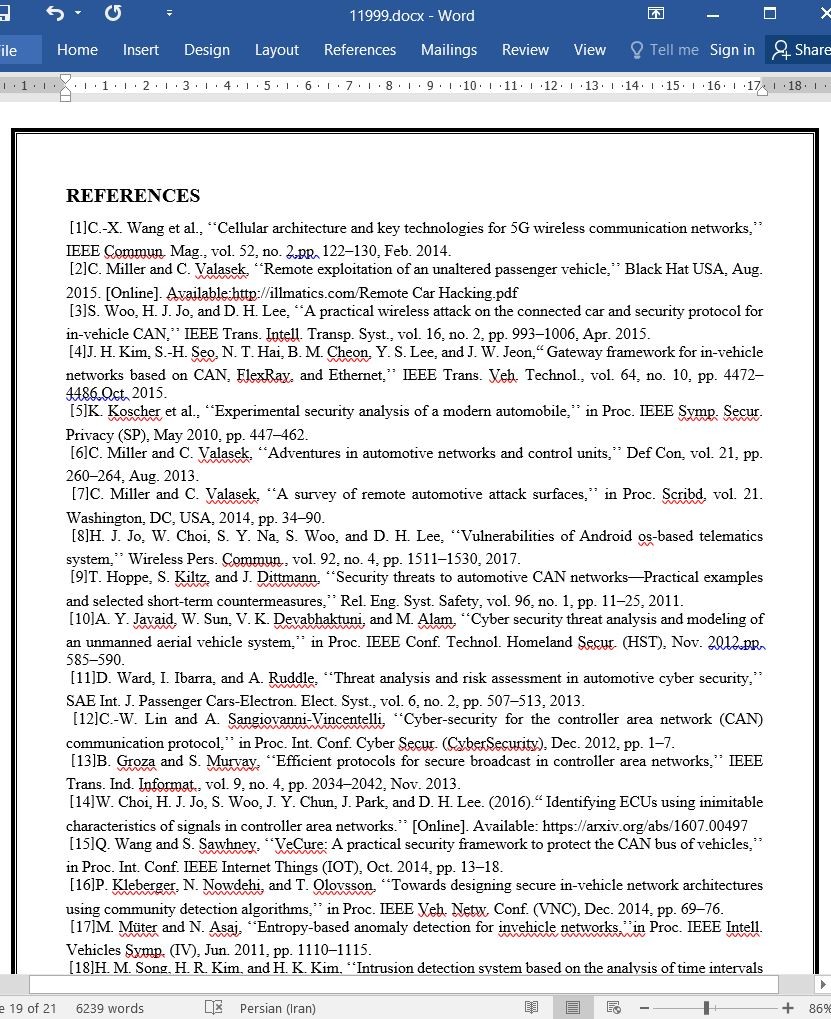
یک سیستم تشخیص آنامولی توزیع شده برای شبکه داخل خودرویی با استفاده از HTM
چکیده
با توسعه فنآوری 5G و اینترنت وسایل نقلیه، احتمال حملات بیسیم از راه دور بر یک شبکه داخل خودرویی، توسط محققان امنیتی به اثبات رسیده است. فنآوری تشخیص آنومالی میتواند به عنوان اولین خط دفاع امنیتی، بهطور مؤثری تهدیدات امنیتی را کاهش دهد. بر این اساس، این مقاله یک سیستم تشخیص آنامولی توزیعشده را با استفاده از حافظه موقت سلسله مراتبی (HTM) برای بهبود امنیت باس شبکه در سطح کنترلگر خودرویی ارائه میدهد. مدل HTM میتواند دادههای جریان را در زمان واقعی پیشبینی کند که این امر به وضعیت یادگیری قبلی بستگی دارد. علاوه براین، ما مکانیسم امتیاز غیرعادی را برای ارزیابی پیشبینی، اصلاح کردیم و بهطور دستی تغییرات میدانی و حمله بازپخش را در میدان دادهها ترکیب نمودیم. در مقایسه با شبکههای عصبی بازگشتی و مدلهای تشخیص مدل پنهان مارکوف، این نتایج نشان میدهند که سیستم تشخیص آنامولی توزیعشده مبتنی بر شبکههای HTM، در حوزههایی که تحت امتیاز منحنی مشخصه عملیاتی گیرنده و همچنین دقت و یادآوری بکار گرفته میشود، عملکرد بهتری دارد.
1. مقدمه
با توسعه سریع فنآوری اینترنت تلفن همراه، رایانش ابری و دادههای بزرگ، خودروها بهتدریج هوشمند و شبکه محور میشوند. شبکه خودروهای هوشمند مسیر جدیدی در توسعه و فنآوری است. مفاهیم و فنآوریهایی مانند خلبان خودکار، ماشین مشترک، و اینترنت وسایل نقلیه (IoV) در زمانی که لازم باشد پدیدار میشوند. 5G توسط صنعت به عنوان یک فنآوری کلیدی در نظر گرفته شده که رانندگی اتوماتیک و ارتباطات شبکه را تحقق میبخشد (1). از مزیتهای آن میتوان به تأخیر پایین، پهن باند بزرگ و تراکم اتصال بالا اشاره کرد. علاوه براین، مدرنترین خودروها مجهز به سیستم پردازش اطلاعات از راه دور چندکاره میباشند که به سیستم موقعیتیابی جهانی (GPS)، تفریحات رسانهای یا حتی دسترسی مستقیم به شبکههای تلفن همراه کمک میکنند. بااینحال، سیستم پردازش اطلاعات از راه دور در برابر حملات شبکه آسیبپذیر است، زیرا این سیستم به یک شبکه بیسیم خارجی متصل است (2)-(4). مهاجم میتواند از طریق اینترفیس دسترسی بیسیم، به شبکه خودروی هدف دسترسی پیدا کند و حملات مختلفی مانند حمله بازپخش، حمله DoS، بویش چارچوب، تزریق چارچوب، و غیره را اجرا نماید (6)-(8). بنابراین، شبکه خودرو را با تهدیدات امنیتی بالقوهای مواجه میکند.
ABSTRACT
With the development of 5G and Internet of Vehicles technology, the possibility of remote wireless attack on an in-vehicle network has been proven by security researchers. Anomaly detection technology can effectively alleviate the security threat, as the first line of security defense. Based on this, this paper proposes a distributed anomaly detection system using hierarchical temporal memory (HTM) to enhance the security of a vehicular controller area network bus. The HTM model can predict the flow data in real time, which depends on the state of the previous learning. In addition, we improved the abnormal score mechanism to evaluate the prediction. We manually synthesized field modification and replay attack in data field. Compared with recurrent neural networks and hidden Markov model detection models, the results show that the distributed anomaly detection system based on HTM networks achieves better performance in the area under receiver operating characteristic curve score, precision, and recall.
I. INTRODUCTION
With the rapid development of mobile Internet, big data and cloud computing technology, the automobile gradually become intelligent, network oriented. The intelligent car network is a new direction of innovation and development. Concepts and technologies such as autopilot, shared car, and Internet of Vehicles (IoV) emerge as the times require. 5G is regarded by the industry as the key technology to realize automatic driving and network communication [1]. It has advantages of low delay, large bandwidth and high connection density. Moreover, most modern cars are equipped with multi-function remote information processing system, supporting global positioning system (GPS), media entertainment, or even directly accessing cellular networks. However, the remote information processing system is vulnerable to network attacks because it is connected to the external wireless network [2]–[4]. The attacker can access the target vehicle network through the wireless access interface [5], implement a variety of attacks such as replay attack, DoS attack, frame sniffing, frame injection and so on [6]–[8]. Thus, it brings potential security threats to the vehicle network.
چکیده
1. مقدمه
2. کارهای مرتبط
3. جریان دادههای CAN و حالت آنامولی
A. جریان دادههای کن باس (CAN BUS)
B. تعریف وضعیت آنامولی کن باس
4. سیستم تشخیص آنامولی توزیعشده با استفاده از الگوریتم HTM
A. یک بررسی اجمالی از سیستم تشخیص آنامولی پیشنهادی
B. پیشبینی کننده مبتنی بر الگوریتم یادگیری HTM
C. نمره تشخیص آنامولی
5. آزمایش و نتایج
A. مقدمات آزمایش
B. ارزیابی عملکرد
C. نتایج اصلاح فیلد
D. نتایج فیلد بازپخش
6. نتیجهگیری
منابع
ABSTRACT
I.Introduction
II.Relation Work
III.Can Data Stream and Anomaly State
A. CAN BUS DATA STREAM
B. CAN BUS ANOMALY STATE DEFINITION
IV.Distributed Anomaly Detection System Using HTM Algorithm
A. OVERVIEW OF PROPOSED ANOMALY DETECTION SYSTEM
B. PREDICTOR BASED ON HTM LEARNING ALGORITHM
C. ANOMALY SCORE FOR DETECTION
V.Experiment and Results
A. EXPERIMENT SETUP
B. PERFORMANCE MEASURE
C. FIELD MODIFICATION RESULTS
D. FIELD REPLAY RESULTS
VI.Conclusion
REFERENCES
- اصل مقاله انگلیسی با فرمت ورد (word) با قابلیت ویرایش
- ترجمه فارسی مقاله با فرمت ورد (word) با قابلیت ویرایش، بدون آرم سایت ای ترجمه
- ترجمه فارسی مقاله با فرمت pdf، بدون آرم سایت ای ترجمه



